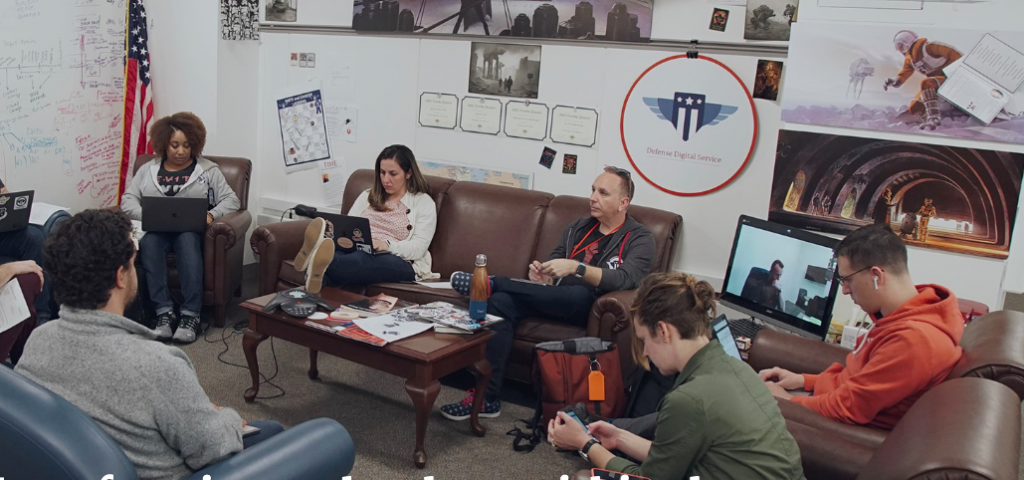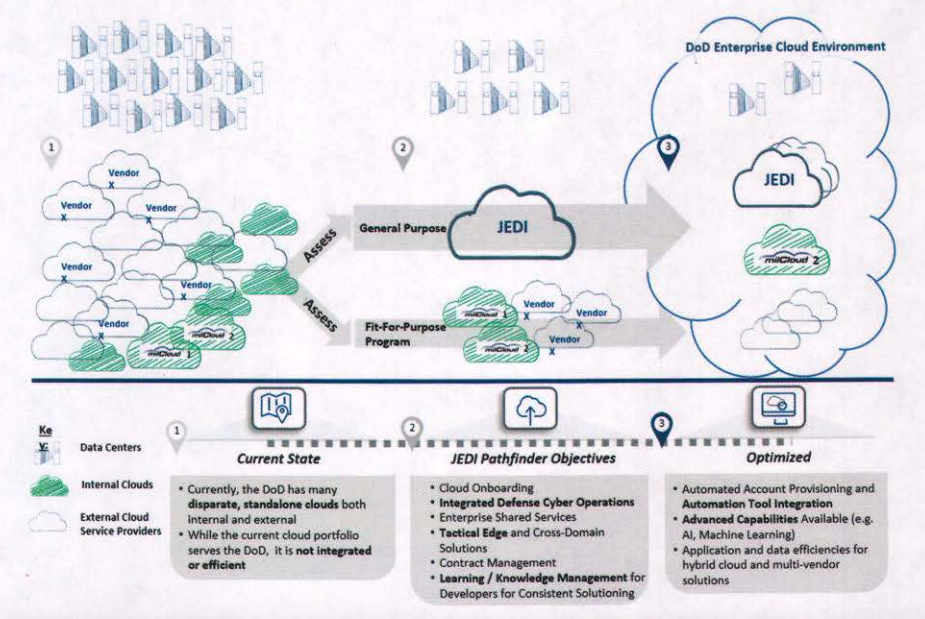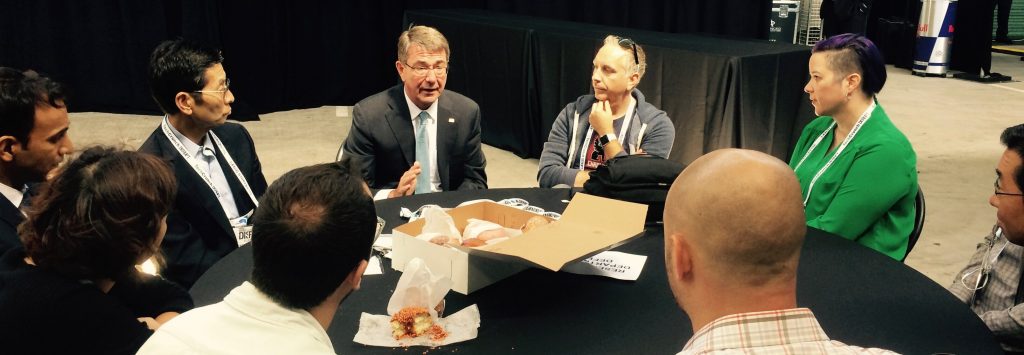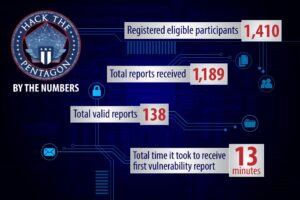No Regrets On JEDI Cloud: DDS Chief Chris Lynch
Posted on

Defense Digital Service director Chris Lynch (at center, in grey hoodie) surrounded by his casually clad tech geniuses.
PENTAGON: “I would never have changed a single thing about how we did JEDI,” Chris Lynch told me in his Pentagon office. “I don’t think we should ever make a decision about the things that we work on and the things we do based on the fear or threat of backlash.”
The 10-year, $10 billion Joint Enterprise Defense Infrastructure program, which will move many military networks to a private-sector cloud, has already faced a lawsuit from disappointed competitor Oracle, a GAO protest from IBM, and skepticism from Congress. A Defense Department inquiry admitted there were “potential conflicts of interest” that required further investigation but argued they didn’t skew the competition in favor of the presumptive favorite, Amazon Web Services. (Microsoft is the only other contender still in the running). JEDI is also the biggest test to date for Lynch and his Defense Digital Service, a self-described “SWAT team of nerds” who volunteer to spend six to 24 months in the Pentagon to infuse tech sector skills and speed into the staid bureaucracy.
Wearing his trademark hoodie and jeans, his walls covered with Star Wars posters and multi-colored whiteboard brainstorms, the outspoken Lynch embodies the revolution — or, as the posters put it, the Rebellion — he’s sought to bring to the Pentagon. In 2015, he became the first director of the Defense Digital Service. Since then, the DDS has outlived two defense secretaries, deployed civilian coders to Afghanistan and Iraq, empowered young troops whose tech skills had been ignored by their superiors, and deployed a host of high-speed fixes, from a website to help military families move to an electronic jammer that protects combat troops from deadly drones.

The Defense Department’s strategy to transition to cloud computing. Note the prominent role for the JEDI project. (Click to expand)
Not The Last Jedi
The $10 billion, 10-year cloud Joint Enterprise Defense Infrastructure (JEDI) program is the biggest thing DDS has done to date and the greatest test of its hyperdrive approach to acquisition. Now Lynch is leaving — having already spent twice as long in government service as any of his high-speed subordinates — with the JEDI competition, still in progress, under intense scrutiny.
“You can’t start with JEDI at an organization like this. You have to build to it,” Lynch told me. “You have to have a world-class acquisition team… You have to have a number of different things that you’ve already done that prove [you’ll] ultimately be successful. ….You have to have a deep understanding of the security requirements.”
“That is the result of literally years and years of us … working one step at a time on small projects, slowly expanding it to a larger project, growing out the team,” Lynch said. “If you look at where we came in, we had to learn how to do a very small simple acquisition with Hack the Pentagon.”
That was DDS’s drive to crowdsource cybersecurity, awarding “bug bounties” to independent security testers and white hack hackers who reported undiscovered weak points in Defense Department systems. It led to spinoffs at the Army, Air Force, and elsewhere, with over 5,000 verified vulnerabilities reported to date and tens of millions in contracts to crowdsourcing firms.
From Hack The Pentagon, DDS scaled up to larger and larger programs. It’s now soliciting industry proposals for SABER (System for Automated Background Evaluation and Review), a project to write software streamlining the notoriously cumbersome security clearance process. DDS also grew beyond its initial focus on improving back-office IT functions to working closely with uniformed personnel, from junior troops to four-star combatant commanders in the Pacific and Middle East.
DDS Overview – Highlights by BreakingDefense on Scribd
“In the beginning, we were mostly working on the business systems, Lynch said. Since then, “we’ve been to some pretty austere places and we do code while we’re out there…in Afghanistan… in Iraq. [Today,] we have amazing relationships with one, two-, three-, four- star generals around the world, not because we tell them that we’re going to do things, but because we do things, and they respect that.”
To Lynch, JEDI matters not because of the back-office efficiencies of consolidating hundreds of data centers onto a private-sector company’s cloud — although it will do that. What matters to him is of the potential improvements for operational forces, which make life-or-death decisions based on extracting the right information from masses of raw data. The military plans to deploy JEDI mini-servers on ships, in ground vehicles, even in troops’ backpacks.
“JEDI is not about commercial cloud,” Lynch told me: Cloud is a means, not the ends. “JEDI is a platform to run the mission of national defense across the world, with access to unlimited compute and storage, or nearly unlimited. We do not have that today and there are dire consequences.”
“The fact that people may be upset about what JEDI is,” he said, “is a consequence of the fact that it matters.”

Secretary Carter and Defense Digital Service director Chris Lynch (on Carter’s left) talk to potential recruits at the TechCrunch conference in San Francisco in 2016.
Beyond JEDI: How Large A Legacy?
The success or failure of JEDI will be the most obvious, expensive piece of Lynch’s legacy. But it’s not the only one. It’s also important whether the Defense Digital Service he’s headed since its inception can endure without him, just as it outlasted the Defense Secretary who created it, Ash Carter. (“Chris Lynch is a trail blazer,” Carter said in a statement today. “He and his Defense Digital Service team … have launched groundbreaking programs that have literally changed – and saved – lives.”)
One positive sign: Lynch’s successor, Brett Goldstein — who’s worked eclectically in the Navy Department, academe, venture capital, and the Chicago police — was handpicked by Acting Defense Decretary Patrick Shanahan and will report directly to him.
But Lynch’s nonchalance about whether his institution survives is as un-Washington as the DDS dress code. “From the very beginning, I made a very conscious decision to never worry about the longevity of the organization,” he told me. Survival should result from success, not be equated with it. “Longevity is not something anyone here should just assume,” he said. “We have to continue to earn that every day.”
That said, the Defense Digital Service has an impact that goes beyond the success or failure of any particular project, or even whether DDS itself lives or dies. In the biggest possible picture, the significance of the service lies in its contribution to bridging the gap between the nation’s defenders and its innovators — whether those innovators are civilians or hidden unappreciated within the military’s own ranks.
While DDS has about 50 civilians and 20 uniformed service members right now, the intentionally high turnover means it has many times that number of graduates who have returned to industry or regular Defense Department jobs, carrying the DDS culture like a benign virus.
“It gets stuck in your heart and mind,” Lynch said. “When people leave here, they leave feeling they did something of consequence… We have an alumni network and sometimes those people come back” to work with DDS on specific projects.
DDS’s Jyn initiative — named after Rogue One heroine Jyn Erso — has expanded its impact even further by recruiting technically talented military personnel, via a Google Hire website no less, to work on pilot projects in such things as cybersecurity and anti-drone defense. Originally launched in conjunction with Army Cyber Command, which has now created the Tatooine center at its Fort Gordon, Ga. cyber-training school, Jyn has now expanded to the other services.
“We have incredibly talented software engineers who are in uniform,” Lynch said, but many of them are hung up in the security clearance process, lack access to modern coding tools, or simply assigned by the notoriously cookie-cutter personnel bureaucracy to jobs that don’t use their talent. One new Navy ensign, for example, was “waiting on their clearance and counting push-ups” until DDS tapped them for its counter-drone project.
Outside Perspectives
Managing its own in-house talent better has long been a major struggle for the military, one which Army Secretary Mark Esper has made his top priority for 2020. Another chronic struggle has been recruiting high-tech talent. That’s especially hard for the armed forces since they recruit tens of thousands of 18-year-olds and then train them up in-house, rather than tap into the much larger talent pool of people in their 20s, 30s, and 40s who’ve grown their skills in the thriving private sector.
“One of the most difficult things we have in the military ….is that I recruit kids that are 18,” said Lt. Col. Natalie Vanatta, deputy chief of research at West Point’s Army Cyber Institute. “If someone decides instead to start their life out in industry, and they do amazing things, and then they want to give back to the their country….you might be the world’s genius, but you can’t join me.
“DDS and its various offshoots have been a tremendous game changer to demonstrate to the rest of the world that this is important, figuring out how to bring outsiders in with their skillset and expertise,” Vanatta told a a New America conference. “We need to continue to build on this, but not as something separate. We need to integrate this into the entire workforce.”
Small elite teams are great, Vanatta said, but to scale up success, the military can’t “make everyone have to be such a cool cat — which Chris Lynch absolutely is.”
“I’m a big fan” of DDS, Ghost Fleet author Peter Singer told me after the panel. “But even at its highest level, there’s still a gap.” The US needs something much larger, he argued: perhaps the cyber equivalent of the Civil Air Patrol — private pilots who searched for submarines in World War II, ferry urgent supplies to disaster zones and have helped guard airspace after 9/11. Or, a similar model, the Coast Guard Auxiliary, whose volunteers teach boat safety and inspect small craft for seaworthiness.
In the biggest possible picture, the most important impact of the Defense Digital Service will be whether it sows the seeds for a much larger collaboration between the nation’s protectors and its innovators.
Subscribe to our newsletter
Promotions, new products and sales. Directly to your inbox.








